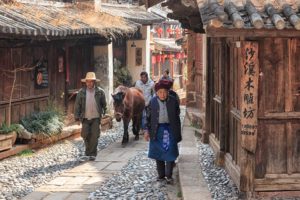
Extract from WildChina
China’s southwestern province of Yunnan encompasses a wide range of scenery, architecture, and culture. Across this diverse province is a winding trade route survived from the Tea Horse Road.
As the primary link through the Himalayas, the Tea Horse Road once served as the passageway for trade along the western frontiers of China. Its name derives from each region’s best commodities – tea from southern China and horses from Tibet. Eventually as trade flourished, this trade network expanded, stretching past southern China and Tibet to extend through Myanmar, Nepal, and India.
The land network of the Tea Horse Road is thought to have been the longest ancient trade route in the world, and the journey was not an easy one. Today, easier and more efficient methods of trade have left the ancient paths of the Tea Horse Road largely abandoned. However, for those who know where to look, remnants of the route and its age-old travelers live on today. And right now, we’re looking at Yunnan.
 Shaxi
Shaxi
The small market town of Shaxi is sometimes included as a pit stop on the road between Dali and Lijiang, if not overlooked altogether. In our opinion, this is a mistake, as the town has a long history and much to offer still. Shaxi was a well-known stop on the Tea Horse Road, and the cobbled streets of Sideng Square provide a glimpse into the past, when horses and tradesmen bustled about in the dust, seeking a short respite from their long journey. […]
Lijiang
 Just outside the well-trodden Old Town of Lijiang lies the small village of Shuhe, where ancient canals funnel running water through the individual architecture of the resident Naxi minority. The Naxi people played an integral role on the Tea Horse Road, so spending time in Shuhe learning about their culture and religious beliefs is recommended. Additionally, a more literal representation of the Tea Horse Road can be found here – The Tea Horse Road Museum. While the museum is primarily in Chinese, English-speaking visitors are still able to enjoy the historical and cultural relics of past traders’ journeys on display.
Just outside the well-trodden Old Town of Lijiang lies the small village of Shuhe, where ancient canals funnel running water through the individual architecture of the resident Naxi minority. The Naxi people played an integral role on the Tea Horse Road, so spending time in Shuhe learning about their culture and religious beliefs is recommended. Additionally, a more literal representation of the Tea Horse Road can be found here – The Tea Horse Road Museum. While the museum is primarily in Chinese, English-speaking visitors are still able to enjoy the historical and cultural relics of past traders’ journeys on display.
 Shangri-La
Shangri-La
The high-altitude mountain-scape of Shangri-La, bustling with Tibetan culture and lamaseries, begs no question that this was once a stop on the Tea Horse Road. Here, the teas originally harvested from further down the Tea Horse Road in places like Xishuangbanna and Dali, are mixed with yak butter in the traditional Tibetan style. Yak butter tea is common all over Tibet, with local tea houses full of Tibetans sipping on the creamy liquid, soaking up its warming properties to aid in fighting the harsh, cold climate that Tibet calls home. […]



